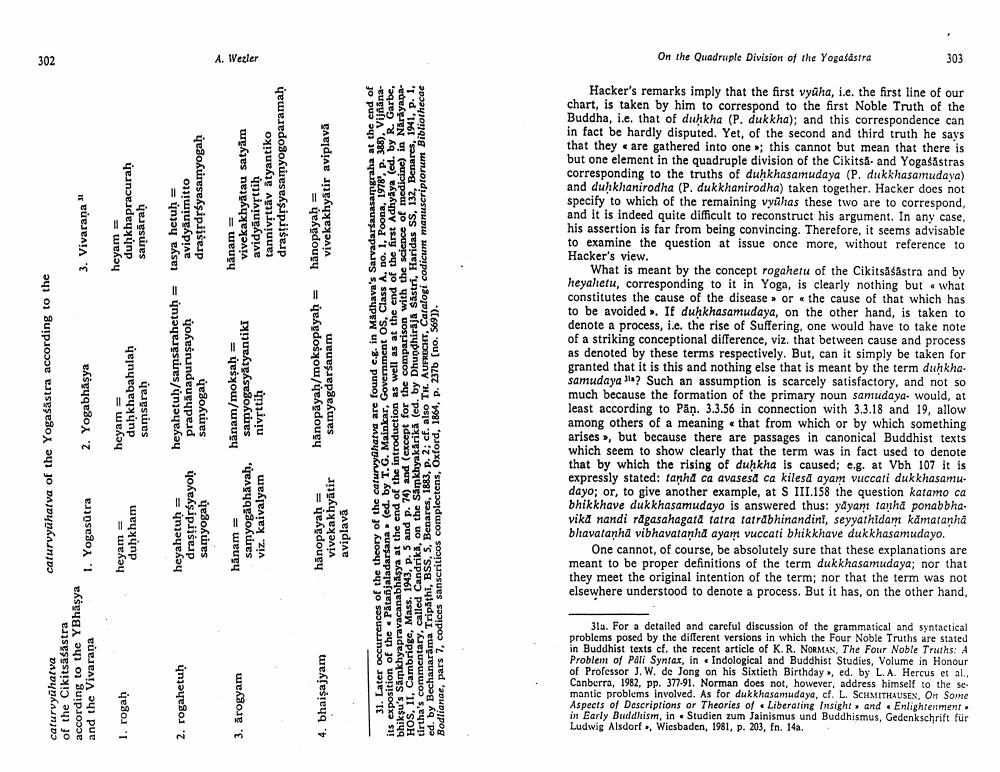Book Title: On Quadruple Division Of Yogasastra Author(s): A Wezler Publisher: A Wezler View full book textPage 8
________________ 302 A. Wezler On the Quadruple Division of the Yogasastra 303 duḥkhapracurah heyam = samsāraḥ tasya hetuh = avidyānimitto drastrdssyasamyogah vivekakhyātau satyam drastrdryasamyogoparamah tannivșttav atyantiko avidyānivșttih hānam = vivekakhyātir aviplavā hanopayah 3. Vivarana caturvyahatva of the Yogasastra according to the 2. Yogabhăşya heyahetuh/samsārahetuh = pradhanapuruşayoh samyogah duhkhabahulah heyam = samsāraḥ hānam/mokṣaḥ = samyogasyatyantiki nivsttih Hacker's remarks imply that the first vyúha, i.e. the first line of our chart, is taken by him to correspond to the first Noble Truth of the Buddha, i.e. that of dukha (P. dukkha); and this correspondence can in fact be hardly disputed. Yet, of the second and third truth he says that they are gathered into one; this cannot but mean that there is but one element in the quadruple division of the Cikitsa- and Yogasastras corresponding to the truths of duḥkhasamudaya (P. dukkhasamudaya) and dunkhanirodha (P. dukkhanirodha) taken together. Hacker does not specify to which of the remaining vahas these two are to correspond, and it is indeed quite difficult to reconstruct his argument. In any case, his assertion is far from being convincing. Therefore, it seems advisable to examine the question at issue once more, without reference to Hacker's view. What is meant by the concept rogahetu of the Cikitsasastra and by heyaletu, corresponding to it in Yoga, is clearly nothing bu constitutes the cause of the disease or the cause of that which has to be avoided. If dunkhasamudaya, on the other hand, is taken to denote a process, i.e. the rise of Suffering, one would have to take note of a striking conceptional difference, viz. that between cause and process as denoted by these terms respectively. But, can it simply be taken for granted that it is this and nothing else that is meant by the term dukha. samudaya ? Such an assumption is scarcely satisfactory, and not so much because the formation of the primary noun samudaya. would, at least according to Pån. 3.3.56 in connection with 3.3.18 and 19, allow among others of a meaning that from which or by which something arises, but because there are passages in canonical Buddhist texts which seem to show clearly that the term was in fact used to denote that by which the rising of duḥkha is caused; e.g. at Vbh 107 it is expressly stated: tanha ca avasesd ca kilesd ayam vuccati dukkhasamu. dayo; or, to give another example, at S III.158 the question katamo ca bhikkhave dukkhasamudayo is answered thus: ydyam tanha ponabbha. vika nandi ragasahagata tatra tatrabhinandini, seyyathidam kamatanha bhavataṇhd vibhavatanha ayam vuccati bhikkhave dukkhasamudayo. One cannot, of course, be absolutely sure that these explanations are meant to be proper definitions of the term dukkhasamudaya; nor that they meet the original intention of the term; nor that the term was not elsewhere understood to denote a process. But it has, on the other hand, hanopāyaḥ/moksopāyah = samyagdarśanam 31. Later occurrences of the theory of the caturvyahatva are found c.g. in Madhava's Sarvadarsanasamgraha at the end of its exposition of the Patanjaladarsana. (ed. by T. G. Mainkar, Government Os, Class A, no. 1, Poona, 1978. p. 388), Vijana bhiksu's Samkhyapravacanabhasya at the end of the introduction as well as at the end of the first Adhyâya (ed. by R. Garbe, HOS, II, Cambridge, Mass. 1943, p. 5 and p. 74) and (except for the comparison with the science of medicine) in Nardyapatirtha's commentary, called Candrika, on the Samkhyakärikā (ed. by Dhundhiraja Sastri, Haridas SS, 132, Benarcs, 1941, P. 1, ed. by Bechanarama Tripathi, BSS, S, Benares, 1883, p. 2; cf. also TH. AUFRUCHT, Catalogi codicum manuscriptorum Bibliothecae Bodlianae, pars 7, codices sanscriticos complectens, Oxford, 1864, p. 237b (no. 5691). 1. Yogasutra heyam = duhkham heyahetuh = drastrdryayoh samyogah samyogabhāvah. viz. kaivalyam hānam = hānopāyaḥ = vivekakhyātir aviplavā caturvyuharva of the Cikitsasastra according to the YBhäşya and the Vivarana 2. rogahetuh 1. rogah 31a. For a detailed and careful discussion of the grammatical and syntactical problems posed by the different versions in which the Four Noble Truths are stated in Buddhist texts cf. the recent article of K. R. NORMAN, The Four Noble Truths: A Problem of Pali Syntar, in Indological and Buddhist Studies, Volume in Honour of Professor J. W. de Jong on his Sixtieth Birthday, ed. by L.A. Hercus et al., Canberra, 1982, pp. 377-91. Norman does not, however, address himself to the se mantic problems involved. As for dukkhasamudaya, cf. L. SCHMITHAUSEN, On Some Aspects of Descriptions or Theories of Liberating Insight and Enlightenment in Early Buddhism, in Studien zum Jainismus und Buddhismus, Gedenkschrift für Ludwig Alsdorf, Wiesbaden, 1981, p. 203, fn. 14a. 3. arogyam 4. bhaisajyamPage Navigation
1 ... 6 7 8 9 10 11 12 13 14 15 16 17 18 19 20 21 22 23 24 25
